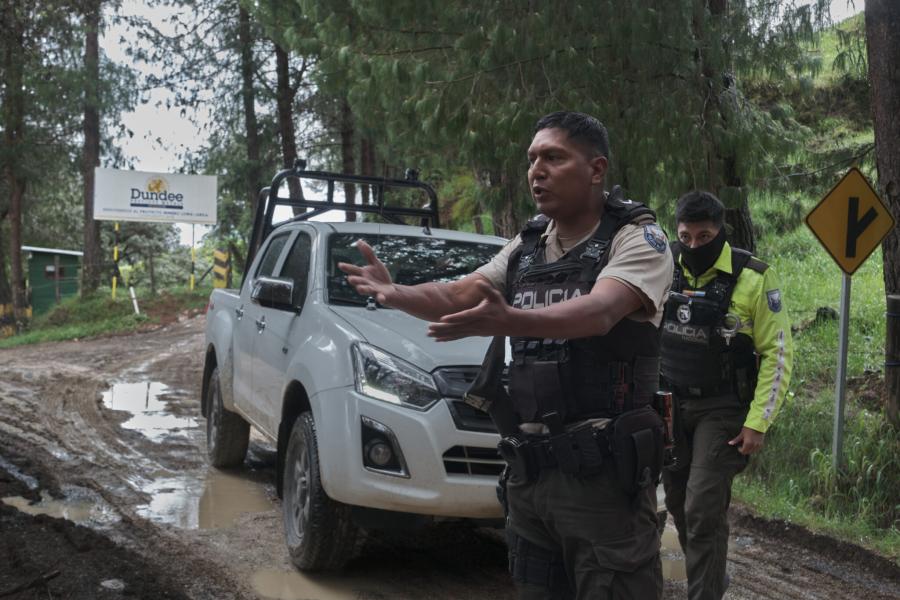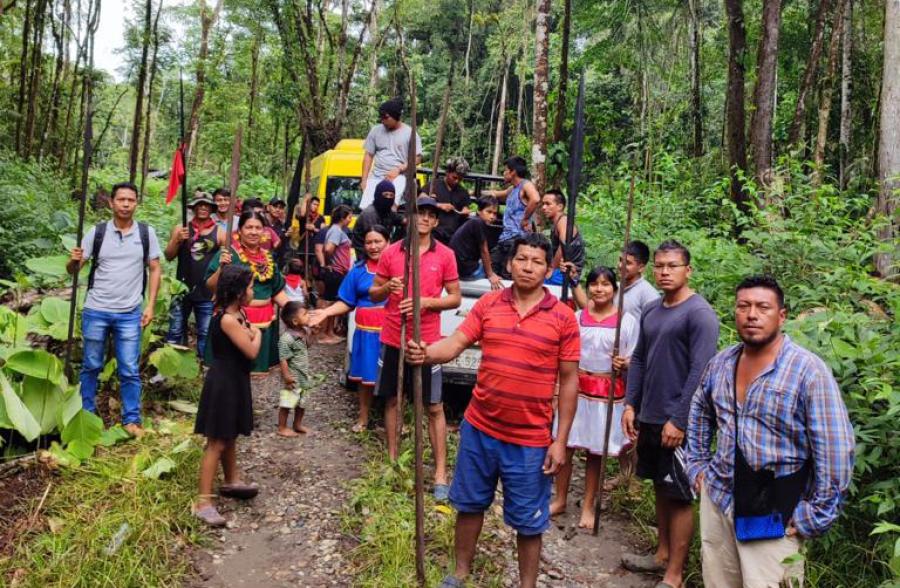The Indians of Amazonia and elsewhere have often been characterized as being lazy. Teaching Indians "how to work" has often been cited as one of the necessary aspects of integrating them into national life. Such stereotypical views ignore the true nature of the labor market operating in northeastern Ecuador where the historic exploitation of Indians and whites persists, and national development and modernization ideologies, while promising better living standards for the people, have not bettered the lives of Amazonian natives to any significant degree.
The Myth of the Unproductive Indian
Prior to discussing specific aspects of Indian-white labor relations it is important to recognize that many whites hold extremely negative and stereotypical views concerning native lifestyles. The following excerpt from the journal of a rubber producer (circa 1913) concerning the Quijos Indians of eastern Ecuador illustrates this fact.
The Indian grows no crops apart from bananas and yucca...for aguardiente and...for chicha...The Indian is absolutely dominated by laziness. He never lends himself voluntarily to the task of earning a single real save for the purpose of getting drunk...if a traveler needs bearers, the authorities have to intervene and force the Indians to do it with threats and even with blows... The Indian works when he is forced to but so badly and for so little that it is worth no more than if he did not work at alt...Generally speaking, the Indian is totally resistant to civilization.
While this account is seven decades old, many Ecuadorians still hold similar views of Indians. In I968, for example, the Summer Institute of Linguistics published a public relations brochure in Ecuador that included the following justification for their program:
One hundred Indian bilingual schools will be necessary to give the jungle Indians the opportunity to leave their ignorance and illiteracy for a level of life that they need in order to be useful Ecuadorian citizens.
The message is clear; Indians living traditional lifestyles are not useful or productive citizens of the national society. Planners and missionaries believe that the Indians can be redeemed through formal education, western religion, and by teaching them the value of labor and money, which are seen as being essential for participation in the national economy.
The view that Indians do not work is, of course, patently false. Their traditional economy is based on slash-and-burn cultivation, hunting, fishing, and the collecting of wild forest products. All of these activities require substantial labor. For example, the Siona and Secoya Indians of the Aguarico River place great emphasis on such work-related skills for men, and gardening, food preparation, and other domestic skills for women.
Recent studies have given considerable emphasis to the work patterns of Amazonian Indians. Generally speaking, they reveal that Indians are expert managers of their subsistence economies, and that these economies have provided them with a satisfactory standard of living.
What seems to dismay many whites is the fact that Amazonian Indians have been able to do this without adhering to a nine-to-five work schedule, and without subjecting themselves to the control of white bosses. Native work patterns are flexible and offer a high degree of personal decision-making, individual freedom, and leisure time. Native economies provide basic subsistence needs and are based on free access to environmental resources. Now that these resources are being diminished or destroyed by outsiders, the argument is that the Indians should become "civilized" by adopting the more rigid and less free proletarian work styles that are characteristic of intensive agricultural or industrial societies.
The Labor Market
In spite of the developmentalist view that Indians ought to become "workers," the actual labor market that exists in Ecuador's Amazonian frontier is one that offers few desirable opportunities for natives. The only fulltime employment the Secoyas have experienced was their semi-enslavement by a plantation owner on the Napo River in Peru. Their annual "pay" consisted of a few yards of cheap cloth, a machete, and perhaps a few other trade items. Having grown tired of this exploitation, some of the Secoyas left Peru in the early 1940s and migrated into Ecuador to live with their Siona relatives on the Cuyabeno River, a tributary of the Aguarico.
Here the Sionas and Secoyas escaped the tyranny of a full-time patron but were newly exploited by the few illiterate white settlers and river traders in the region. These people entice the Indians, as a casual labor pool, to clear gardens, make canoes, go hunting, and collect commercially viable forest products for the benefit of the whites. Since the early 1970s I have witnessed or been told of dozens of such experiences.
Usually, a trader or settler will arrive in an Indian village and describe his money-making plans to the Indians. He may even try to use fictitious kinship terms such as compadre to emphasize his "goodwill" and "closeness" to potential workers. Once one or more of the Indians have agreed to work for the person they are transported away and are not seen for days, weeks, or even months. Upon returning to the village they recount how they performed the agreed-upon labor and how the trader or settler will soon return with the profits and pay them. At this point the trader usually pulls an extended disappearing act. Ultimately he revisits the village to recruit more workers, but says that he has sent the overdue wages via a relative or another trader. "Hasn't that person arrived with your money? No! Well then, you will have to get it from him...I'm not responsible!" On other occasions the trader will claim that the Indian consumed his wages by drinking the boss's aguardiente while away on the job.
The events described above are not isolated: they are part of a recurring pattern in Indian-white relations in Amazonian Ecuador. Missionaries who have witnessed these patterns over many years refer to these particular trader families as "river rats." The river rats are really small-time entrepreneurs and con artists who make a living by engaging in a variety of petty deals and scams. Whenever these deals require physical work they approach the nearby Indian communities. Many of the Indians are wise to these tactics and therefore give the appearance of "not wanting to work.
Through the 1950s and mid-1960s the river rats offered the only outside employment opportunities for the Siona and Secoya living in Ecuador. By the late 1960s, however, the Aguarico region became the site of extensive oil exploration and production. A major oil discovery was made in 1968 by a consortium of Texaco and Gulf around Lago Agrio, to the west of the Siona and Secoya. Subsequent discoveries were made at Tarapoa and Shushufindi, much closer to Indian settlements.
These oil discoveries and the road construction associated with them had the effect of opening the entire Aguarico Basin to massive colonization and a variety of additional entrepreneurial and agricultural enterprises. Ecuador was, at last, beginning to achieve its long-held aspiration of integrating its Amazonian region into national life and the national economy.
One might suppose that these developments would have also provided the "employment" that Indians seemed to need in order to become "civilized." This has not been the case; the expanding frontier has reduced the territories and resources of the Indians, but it has not provided them with significant employment opportunities. The oil companies did hire a few Indian men for the purpose of clearing forest trails and campsites, but only for short periods of time, and only because Indians were better woodsmen than white laborers. The out-of-work whites and mestizos who flocked to the oilfields also found few permanent employment opportunities because the companies used large numbers of workers only during the early construction phases of the oil development process. After the industrial infrastructure was in place only a few hundred employees were needed to operate and maintain it. Furthermore, the companies hired laborers for very short periods in order to circumvent Ecuadorian labor laws which protect workers who have been continuously employed for more than three months.
Other companies that came into the Amazon region likewise failed to offer employment opportunities for Indians. For example, a large African palm corporation won a 10,000 hectare concession in a former Siona-Secoya hunting territory near the village of San Pablo. But when the forest was cleared for this large agro-industrial complex it was done by bulldozers and not a single Siona-Secoya was needed.
In 1980 several Siona youths were hired at a German-owned sawmill west of San Pablo, but after working for an extended period some were badly burned in an accidental gasoline fire. Following this unfortunate event the Indian workers were fired and were not even paid their past due wages.
Conclusion
These examples of employment opportunities and labor relations are not exhaustive, but they do provide some insights into the dynamics of interethnic relations in northeastern Ecuador and the nature of the frontier-style labor market that confronts Indians. On the one hand Ecuadorians and missionaries proclaim that Indians must learn the value of hard work and participation in the economic system, while on the other no really significant or equitable employment opportunities are available to them.
Indians are very good at managing and using the natural resources in their traditional territories. The future welfare of native communities should not be based on a false hope that Indians will somehow become proletarians, particularly when the local labor market offers few real opportunities for native people and ruthlessly exploits them. Government planners must first insure that native communities have legal title to their traditional lands. This will enable them to continue their very successful and well-adapted subsistence economies and provide the resource base for additional entrepreneurial activities by Indians themselves.
Some Siona-Secoya have already begun to experiment with the raising of such cash crops as maize, rice, coffee, and cacao and domesticated animals such as chickens, pigs, and cattle. While some of these activities may not prove to be viable, such experiments indicate that the Indians are aware of the marketplace and are willing to test it. Wild resources such as timber may also offer some income potential, but only if these resources remain in the hands of the native communities. A number of Siona-Secoya presently use natural materials as the basis of a small-scale artifact trade. Increased tourism also brings income into some of the Indian villages, but has the unfortunate effects of exposure to contagious diseases, harassment of Indian women, increased exposure to alcoholic beverages, and the disruption of daily life and privacy.
There is no quick fix for the problems that Indians will face as the Amazon becomes increasingly developed and integrated into the national economy. Employment in the casual labor market is certainly not the answer for most Amazonian Indians, nor is it the path to "civilization." It most certainly is the path to deculturation, lower-class status in the larger society, and a standard of living that is lower than that enjoyed in most native communities. The best hope for Amazonian Indians lies in the protection of their land and civil rights, and in their abilities to manage their own resources in both traditional and innovative ways.
Article copyright Cultural Survival, Inc.



